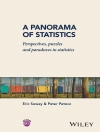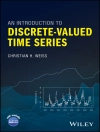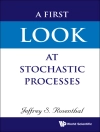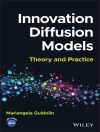Solutions Manual to accompany Introduction to Quantitative Methods in Business: With Applications Using Microsoft Office Excel
Das E-Book Solutions Manual to Accompany Introduction to Quantitative Methods in Business wird angeboten von John Wiley & Sons und wurde mit folgenden Begriffen kategorisiert:
Business & Corporate Economics, Business & Management, Business Statistics & Math, Economics, Finanz- u. Wirtschaftsstatistik, Quantitative Methoden, Statistics, Statistics for Finance, Business & Economics, Statistik, Volks- u. Betriebswirtschaftslehre, Volkswirtschaftslehre, Wirtschaft u. Management, Wirtschaftsmathematik, Wirtschaftsmathematik u. -statistik, Wirtschaftsstatistik
Spis treści
1. The Mathematical Toolbox: A Summary 1
1.2 Linear Functions 1
1.3.1 Solving Two Simultaneous Linear Equations 1
1.4 Summation Notation 2
1.5 Sets 3
1.6 Functions and Graphs 3
1.7 Working with Functions 4
1.8 Differentiation and Integration 5
Solutions to Odd-Numbered Exercises 8
2. Applications of Linear and Nonlinear Functions: A Summary 32
2.2 Linear Demand and Supply Functions 32
2.3 Linear Total Cost and Total Revenue Functions 33
2.4 Market Equilibrium 33
2.6 Applications of Nonlinear Functions 34
2.7 Present Value of an Income Stream 35
2.8 Average Values 35
2.9 Marginal Values 36
2.10 Elasticity 36
Solutions to Odd-Numbered Exercises 37
3. Optimization: A Summary 47
3.2 Unconstrained Optimization 47
3.2.1 Models of Profit and Revenue Maximization 47
3.2.3 Solution Using the Calculus Approach 47
3.2.5 Solution Using the Calculus Approach 47
3.3 Models of Cost Minimization: Inventory Cost Functions and Economic Order Quantity (EOQ) 48
3.3.2 Solution Using the Calculus Approach 49
3.4 Constrained Optimization: Linear Programming 50
3.4.1 Linear Programming: Maximization 50
3.4.2 Linear Programming: Minimization 51
Solutions to Odd-Numbered Exercises 52
4. What Is Business Statistics? 68
4.3 Descriptive Statistics: Tabular and Graphical Techniques 68
4.4 Descriptive Statistics: Numerical Measures of Central Tendency or Location of Data 70
4.4.1 Population Mean 70
4.4.2 Sample Mean 70
4.4.3 Weighted Mean 70
4.4.4 Mean of a Frequency Distribution: Grouped Data 71
4.4.5 Geometric Mean 71
4.4.6 Median 71
4.4.7 Quantiles, Quartiles, Deciles, and Percentiles 71
4.4.8 Mode 72
4.5 Descriptive Statistics: Measures of Dispersion (Variability or Spread) 73
4.5.2 Variance 73
4.5.3 Standard Deviation 74
4.5.4 Coefficient of Variation 74
4.5.5 Some Important Uses of the Standard Deviation 75
1. Standardization of Values 75
2. Chebysheff’s Theorem 75
4.5.6 Empirical Rule 75
4.6 Measuring Skewness 76
Solutions to Odd-Numbered Exercises 76
5. Probability and Applications 96
5.2 Some Useful Definitions 96
5.3 Probability Sources 96
5.3.1 Objective Probability 96
5.4 Some Useful Definitions Involving Sets of Events in the Sample Space 96
5.5 Probability Laws 97
5.5.2 Rule of Complements 97
5.5.3 Conditional Probability 97
5.5.4 General Multiplication Rule (Product Rule) 97
5.5.5 Independent Events 98
5.5.6 Probability Tree Approach 98
5.6 Contingency Table 98
Solutions to Odd-Numbered Exercises 100
6. Random Variables and Probability Distributions 105
6.2 Probability Distribution of a Discrete Random Variable X 105
6.3 Expected Value, Variance, and Standard Deviation of a Discrete Random Variable 106
6.3.1 Some Basic Rules of Expectation 106
6.3.2 Some Useful Properties of the Variance of X 107
6.4 Continuous Random Variables and Their Probability Distributions 107
6.5 A Specific Discrete Probability Distribution: The Binomial Case 108
6.5.1 Binomial Probability Distribution 108
6.5.2 Mean and Standard Deviation of the Binomial Random Variable 109
6.5.3 Cumulative Binomial Probability Distribution 110
Solutions to Odd-Numbered Exercises 110
Index 119
O autorze
Bharat Kolluri, Ph D, is Professor of Economics in the Department of Economics, Finance, and Insurance at the University of Hartford. A member of the American Economics Association, his research interests include econometrics, business statistics, quantitative decision making, applied macroeconomics, applied microeconomics, and corporate finance.
Michael J. Panik, Ph D, is Professor Emeritus in the Department of Economics, Finance, and Insurance at the University of Hartford. He has served as a consultant to the Connecticut Department of Motor Vehicles as well as to a variety of healthcare organizations. In addition, Dr. Panik is the author of numerous books including Growth Curve Modeling: Theory and Applicationsand Statistical Inference: A Short Course, both published by Wiley.
Rao N. Singamsetti, Ph D, is Associate Professor in the Department of Economics, Finance, and Insurance at the University of Hartford. A member of the American Economics Association, his research interests include the status of war on poverty in the United States since the 1960’s and forecasting foreign exchange rates using econometric methods.












